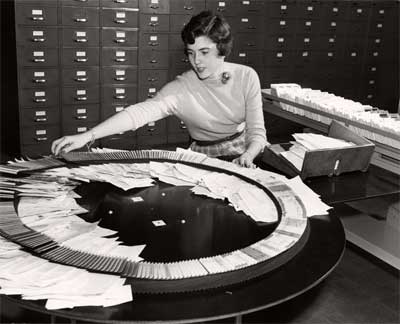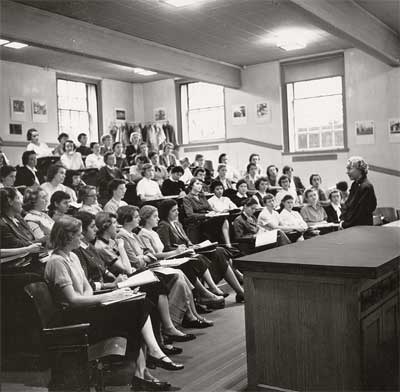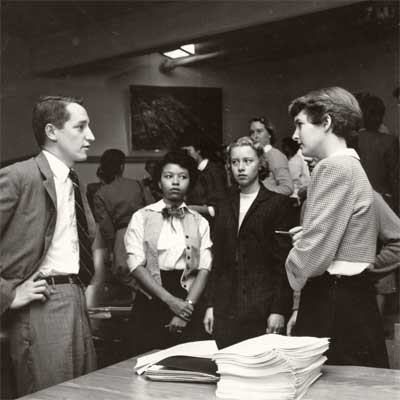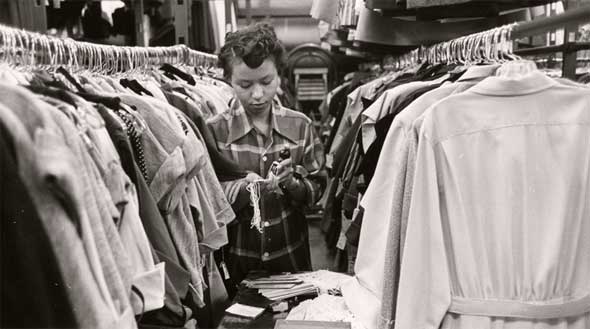

Administration of the Training Course program, now renamed, developed into a joint effort between Radcliffe College and the Harvard Business School when, responding to broad societal changes in the aftermath of World War II, the program’s scale and purpose transformed to include wider organizational and administrative training.
Renamed the Management Training Program in 1944–1945 to emphasize the broader value of educating for management positions, the program experienced a brief postwar enrollment boom. However, by 1951 the numbers of students were decreasing, and the program’s financial future was shaky. Despite the program’s ability to offer “substantial advantages to young women seeking jobs in business, industry, or non-commercial organizations,”4 the President and Council of Radcliffe College voted to discontinue it.
 Harvard-Radcliffe Program in Business Administration student Sheila Morris completing field work, 1957-1958.
Harvard-Radcliffe Program in Business Administration student Sheila Morris completing field work, 1957-1958.
HBS intervened, and worked out a joint administrative agreement with Radcliffe to save the program. While Radcliffe provided facilities and administration, HBS had been providing instructors for the program from its inception. HBS faculty now formally assumed direction of educational policy and a portion of the financial burden of continuing the program. Despite the more formal relationship, the Radcliffe program remained separate from the two-year MBA degree offered by Harvard Business School.
Women who enrolled in the program often had college degrees and work experience, and came from all over the United States and countries such as Canada, the Philippines, England, France, Sweden, Turkey, South Africa, Korea, and India.5 After receiving their certificates, alumnae found positions in industry, personnel, sales, management, publishing, finance, and myriad kinds of specialized work.
Fieldwork remained a core experience through the program’s many changes. As a counterpoint to the case study method of the classroom, it gave students a chance to experience, learn, and report back on both the world of unskilled labor and higher-level administrative tasks. More than two hundred companies hosted fieldwork studies over the duration of the program,6 including Sylvania Electric Products, American Broadcasting Co., Metropolitan Life Insurance, and R. H. Macy.
_thumb.jpg) T. North Whitehead was the program’s longest-serving director (1944–1955) and oversaw an era of reorganization and expansion. Raghnild “Rags” Roberts served as the program’s associate director overseeing the fieldwork assignments that were an essential part of the practical curriculum. Portrait of T. North Whitehead and Raghnild J. Roberts, 1952
T. North Whitehead was the program’s longest-serving director (1944–1955) and oversaw an era of reorganization and expansion. Raghnild “Rags” Roberts served as the program’s associate director overseeing the fieldwork assignments that were an essential part of the practical curriculum. Portrait of T. North Whitehead and Raghnild J. Roberts, 1952
- 4
- “Report of the Radcliffe College Committee on the Management Training Program,” 1952, p. 25. Vertical File (Arch E73.10A 1952), HBS Archives, Baker Library Historical Collections, Harvard Business School. ←
- 5
- Raghnild J. Roberts, A Short History of the Harvard-Radcliffe Program in Business Administration: 1937-1963 (1964), p. 10. Harvard-Radcliffe Program in Business Administration Records, HBS Archives, Baker Library Historical Collections, Harvard Business School. ←
- 6
- Ibid, p. 9.
- Baker Library | Historical Collections | Site Credits
- Contact Email: histcollref@hbs.edu


